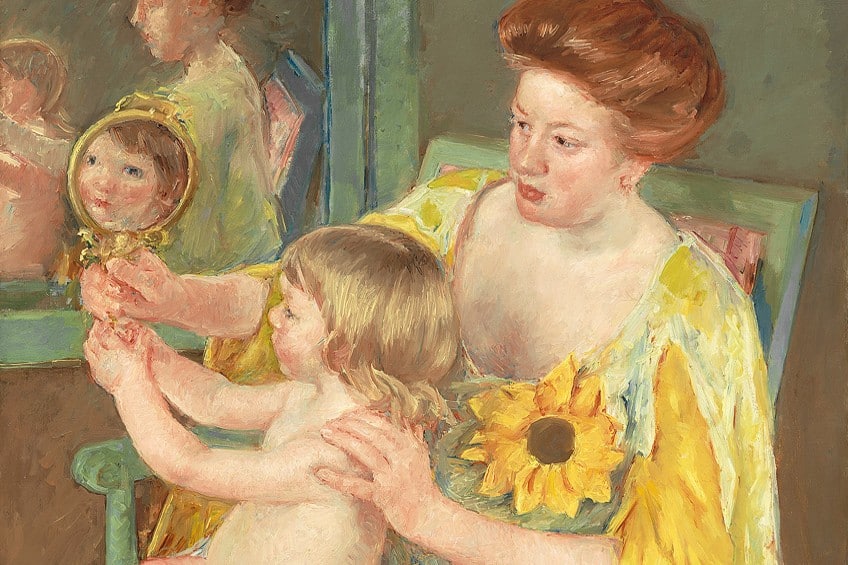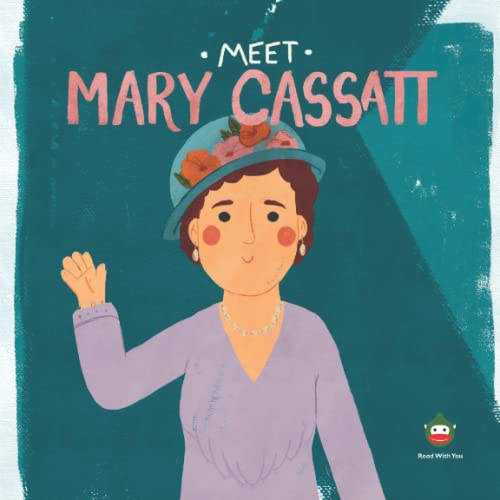Mary Cassatt – A Pioneer of the Impressionism Movement
Mary Stevenson Cassatt was one of the pioneers of Impressionism. Cassatt’s work was seen as being on par with her male colleagues, something that was nearly unheard of at the time. In 1879, Diego Martelli famously described her work as being equal to Edgar Degas in her use of light to illustrate movement. Gustave Geffroy referred to her as one of the three great ladies, the “les trios grandes dames”, alongside Marie Bracquemond and Berthe Morisot.
Contents
Artist in Context: Who Was Mary Cassatt?
| Date of Birth | 22 May 1844 |
| Date of Death | 14 June 1926 |
| Country of Birth | Pittsburgh, Pennsylvania, United States |
| Art Movements | Impressionism |
| Mediums Used | Painting and printmaking |
Cassatt was an American painter and printmaker but spent most of her career in France. She was good friends with Edgar Degas and was one of the very few female artists, and the only American artist, that exhibited with the Impressionists in Paris. Mary Cassatt’s artist style was intimate and often portrayed the everyday lives of women, especially highlighting the nuanced relationships between mothers and their children.
Both her painting style and her way of depicting women in her art, made Cassatt a uniquely modern artist of the late-19th century.
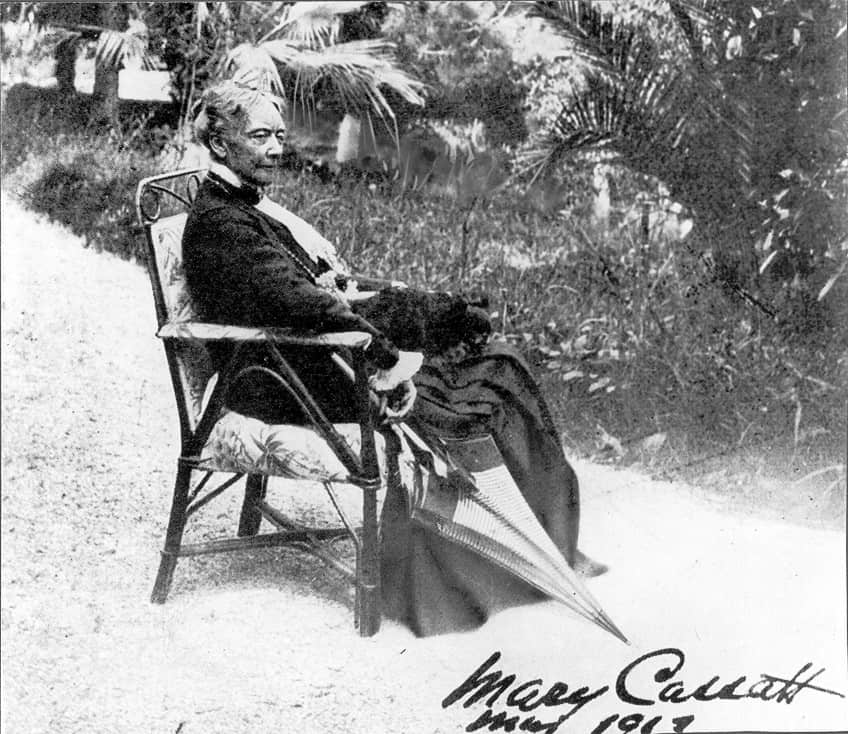
Childhood
Cassatt was born on the 22nd of May 1844 in Pittsburgh, Pennsylvania, which was then called Allegheny City. She was born into an affluent family as one of seven children. In addition to her father, Robert Simpson Cassatt’s, successful career as a banker, politician and businessman, her mother, Katherine Kelso Johnston, was a well-educated woman, also from a banking family. Her wealthy upbringing played an important role in her ability to become a successful female artist in the 19th century.
Cassatt’s family viewed education and traveling as integral to a child’s development. Cassatt started her education at the age of six.
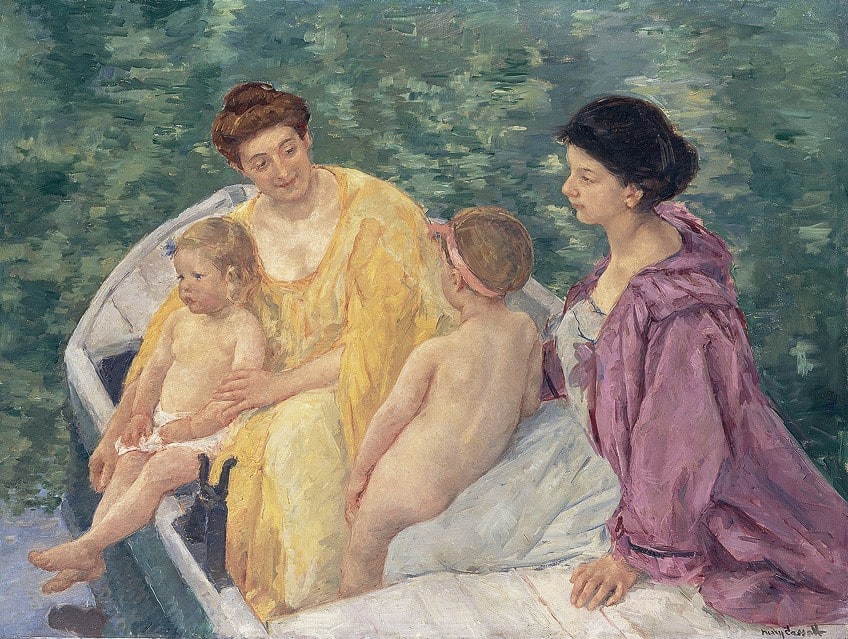
She also spent five years during her childhood traveling through Europe. Most influential was her time in Paris, London, and Berlin, where she studied French and German. Here, she would also begin her lessons in music and drawing. While in Paris in 1855, she visited the Paris World’s Fair where she was first exposed to French artists, such as Ingres, Delacroix, Courbet, Degas, and Pissarro.
Both Degas and Pissarro would later become her colleagues, mentors, and friends.
Early Education
Despite her family’s objections, Cassatt studied painting at the Pennsylvania Academy of Fine Arts in Philadelphia, Pennsylvania, when she was 15 years old. She persisted with her studies during the American Civil War. Her family’s objections were possibly based on their concerns about Cassatt’s exposure to feminist ideas and bohemian behavior at the Academy. Although about 20% of the students were female, most of them did not study art with the end goal of becoming professional artists. Mostly, they viewed art as merely a socially valuable skill for women to have in a respectable society. Cassatt, on the other hand, committed herself to become a full-time, professional artist.
Cassatt, however, soon became impatient with the Academy. At the time, female students were not allowed to draw from live models and were only given casts as references. She also felt patronized by the male students and lecturers. Cassatt abandoned her studies in the academy and decided to opt for independent studies of the old masters instead.
During this time, she had proven to her father that she is serious about her artistic pursuits, and he became more supportive of her choices. In 1866, he allowed for the family to relocate to Paris, where Cassatt would have more opportunities to pursue a career in art. Female students were not allowed to enroll at the Ecole des Beaux-Arts at the time, so Cassatt instead sought to be taught separately by lecturers at the institution. Jean-Leon Gerome, a master at the institution, recognized Cassatt’s talent in her application and agreed to be her private tutor. In addition to her sessions with Gerome, Cassatt also obtained a permit with the Louvre that allowed her to paint copies based on the works of the masters.
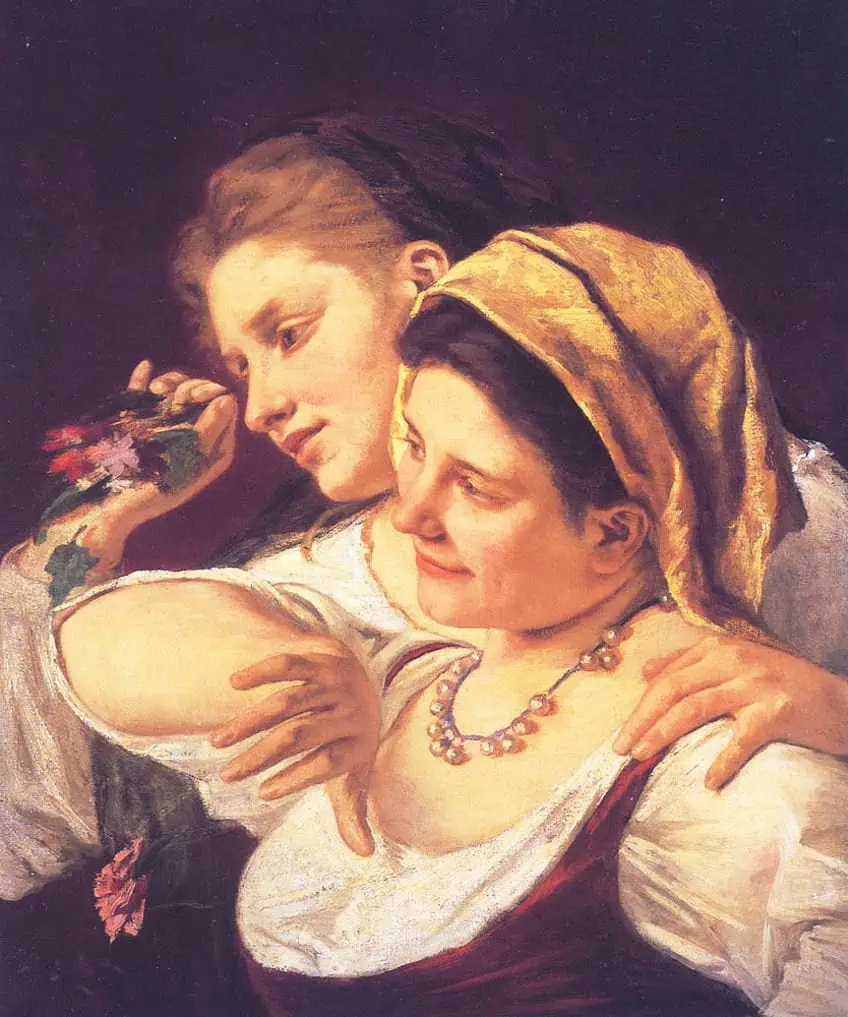
Such permits were often granted to female painters who received little compensation for their painted copies. The museum would be filled daily with such “copyists” and would become a social meeting point for Frenchmen and the female students. Cassatt soon also joined painting classes presented by Charles Chaplin and in 1868 she would study under Thomas Couture. Cassatt returned to America in 1870 when the Franco-Prussian War started. While in America, her father was again opposed to her chosen profession and refused to purchase art supplied for her.
She decided to submit two paintings to a New York Gallery, which received much acclaim, but were not sold. Moreover, she was disappointed by the limited number of paintings to gain inspiration from in America. Her thoughts at one point led her to consider giving up art, as she could not support herself.
Seeking potential for success elsewhere, Cassatt traveled to Chicago, but some of her early works were destroyed in the 1871 Great Chicago Fire. Her work was soon noticed by the archbishop of Pittsburgh, which brought some relief to her. The archbishop commissioned Cassatt to paint two copies of work by Italian artist Correggio. He gave her enough money in advance to fund her travels to Parma, Italy. Cassatt happily departed for Europe once more.
Mature Career
Cassatt received much praise and support in Parma. The art community embraced her and admired her work. In the Salon of 1872, her painting, Two Women Throwing Flowers During Carnival (1872), was well received and purchased. Cassatt soon finished her commission for the archbishop and decided to remain in Europe. She visited Madrid and Seville and created beautiful works there but chose to settle in France where she shared an apartment with her sister.
At the time, Mary Cassatt was an artist who was critical of the Salon’s conventional and traditional tastes and policies. She criticized the Salon for dismissing female painters when they do not have a male acquaintance on the jury. She became increasingly disillusioned by the Salon when they rejected two of her paintings in 1875 only to accept them the following year when she darkened the background to ascribe to their conventional sentiments.
In 1877, both of her applications were rejected, and for the first time, she had no works representing her in the Salon. Cassatt reached an all-time low in her career. However, she was soon invited by Edgar Degas to exhibit with the Impressionists. This would alter the trajectory of her career significantly. The Impressionists were a group of independent artists that began exhibiting their own works in 1874 as a breakaway from the traditional Salon exhibitions. The Impressionist group were much more experimental and forward-thinking in their approach. They had no manifesto and embraced a wide range of styles and techniques.
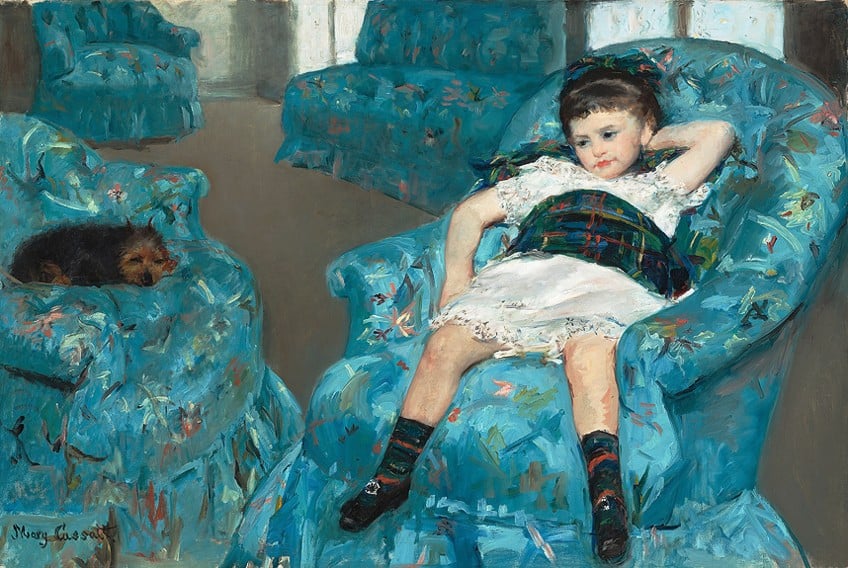
They enjoyed painting in open-air settings and applied paint in bold brushstrokes in vibrant colors. The colors were often not premixed and rather applied next to each other to create illusions of merged colors in motion. There was already one woman in the group, the Impressionist painter Berthe Morisot. Cassatt and Morisot became colleagues and cherished friends. Cassatt thoroughly enjoyed her time with the Impressionists and worked with enthusiasm towards the first planned Impressionist show, planned for 1878. The show, however, was only realized on the 10th of April 1879.
Mary Cassatt’s artist style became freer and more spontaneous, and she enjoyed drawing scenes outdoors and in theaters. Cassatt’s sister, whom she shared an apartment with during her first stay in France, and parents joined her in Paris in 1877. Cassatt enjoyed the company as she never married, believing that marriage would stifle her career aspirations.
Her sister passed away in 1882, after which Cassatt struggled to work for some time. Cassatt’s enthusiasm for doing great work at her first Impressionist show, and her drive to impress Degas, soon inspired her to continue work again. Degas introduced Cassatt to new art mediums, including pastels and copper etchings. She also became the subject in many of Degas’ works. Cassatt’s family also enjoyed Degas’ company and invited him frequently as a dinner guest. Over time, Cassatt developed romantic feelings for Degas, but decided that though he was well dressed and sophisticated, his nature was too fickle.
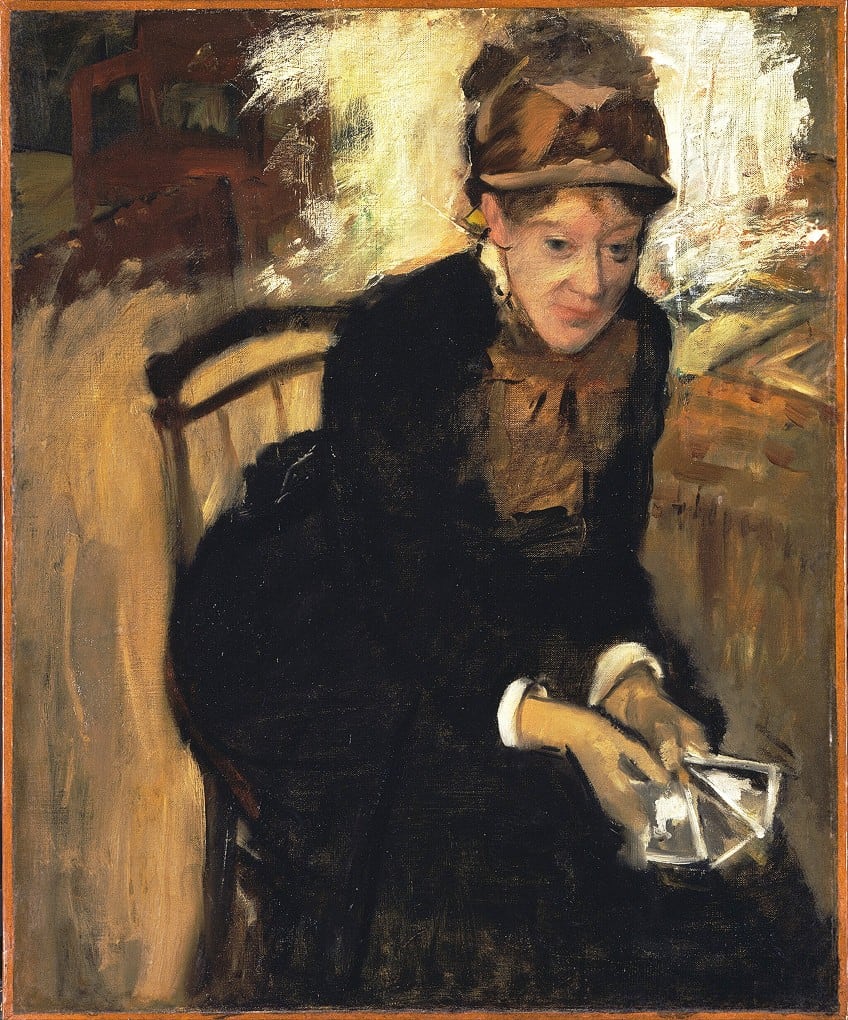
The 1879 Impressionist show was a great success. It was a profitable exhibition for Cassatt and all the other exhibitors. Cassatt exhibited 11 works at the first show and continued to exhibit in the following Impressionist exhibitions, in 1880 and 1881. Cassatt remained an active participant in the group until 1886. In the same year, Cassatt presented two works to the first Impressionist exhibition held in America. Cassatt also played an advisory role for her friend Louisine Elder and her husband Harry Havemeyer, who were major collectors of Impressionist art. Much of their collection is on display at the New York City’s Metropolitan
Later Years
By 1886, Cassatt no longer identified with any specific art movement. She developed her work into her own unique style that favored experimentation with various art forms and techniques. A golden thread through her work is her keen observation skills and sensitive execution. Her subject matter remained unsentimental and modern. Most noteworthy is her unsentimental depictions of mother and child relationships that are not idealized, but rather realistic depictions including honest emotions such as boredom, exhaustion, and love.
From 1990, most of her work featured mother and child drawings, prints, and paintings, yet Cassatt never had children of her own.
Over time, Cassatt increasingly valued simplicity in her work. This reached a high point when she studied the simplicity of Japanese design. In 1890, Cassatt visited a Japanese master’s show in Paris that inspired her greatly. The following year, she exhibited a collection of drypoint and aquatint prints in style and colors clearly reminiscent of Japanese design. The prints were highly original in soft pastel colors and included Woman Bathing (1890-1891), Maternal Caress (1890 – 1891), and The Coiffure (1890 – 1891).
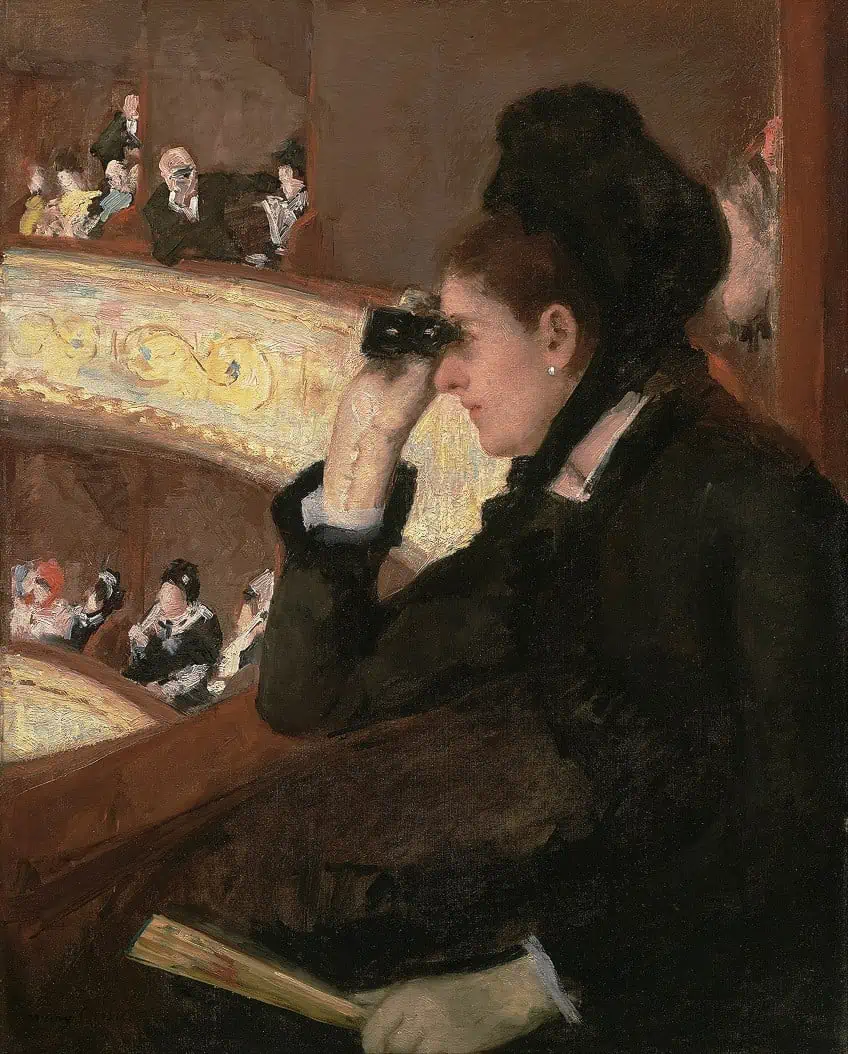
During the 1980s and 1990s, Cassatt became more involved in the American art scene, taking on more advisory roles. Although she continued excelling in her own artistic development, she received less recognition in America, compared to Europe. This might partly be due to the success of her brother, Alexander Cassatt, which overshadowed her own. Her brother was the president of the Pennsylvania Railroad and passed away in 1906. Although Cassatt had a close relationship with her brother, she remained productive in her work until 1910.
In 1910, Cassatt traveled to Egypt. She was so overwhelmed with the ancient arts in Egypt that it nearly stifled her own creativity. She explained that she was “crushed by the strength of this art”.
In 1911, Cassatt’s health deteriorated, and she was diagnosed with diabetes, cataracts, rheumatism, and neuralgia. She continued working until 1914, when she was forced to stop painting due to near blindness. In 1915, Cassatt exhibited 18 older works in support of the women’s rights movement. Cassatt passed away on the 14th of June in 1926 at the Chateau de Beaufresne near Paris. She was buried in France in her family’s vault.
Important Mary Cassatt Prints and Paintings
Mary Cassatt’s paintings and prints are a testimony to the kind of woman she was. Her works are delicate, detailed, modern, brave, and representative of the shifts in society at the time. Most notable is her portrayal of the female experience in late 19th century Europe and America. Below we unpack a small selection of some of her most important works.
Portrait of the Artist (1878)
| Artwork Title | Portrait of the Artist |
| Date | 1878 |
| Medium | Watercolor, gouache on wove paper laid down to buff-colored wood-pulp paper |
| Size (cm) | 60 x 41.1 |
| Collection | Metropolitan Museum of Art, New York City, United States |
This famous painting is a Mary Cassatt self-portrait and is one of only two known portraits that the artist painted of herself. The work was painted a year after receiving Edgar Degas’s invitation to show her work with the Impressionists. Through the soft green color of the background, the complementary juxtaposed use of color, and the asymmetrical composition alludes to the strong influence Degas had on Cassatt’s work.
Mary Cassatt’s self-portrait was bought in 1879 by Mrs. H. O. Havemeyer.
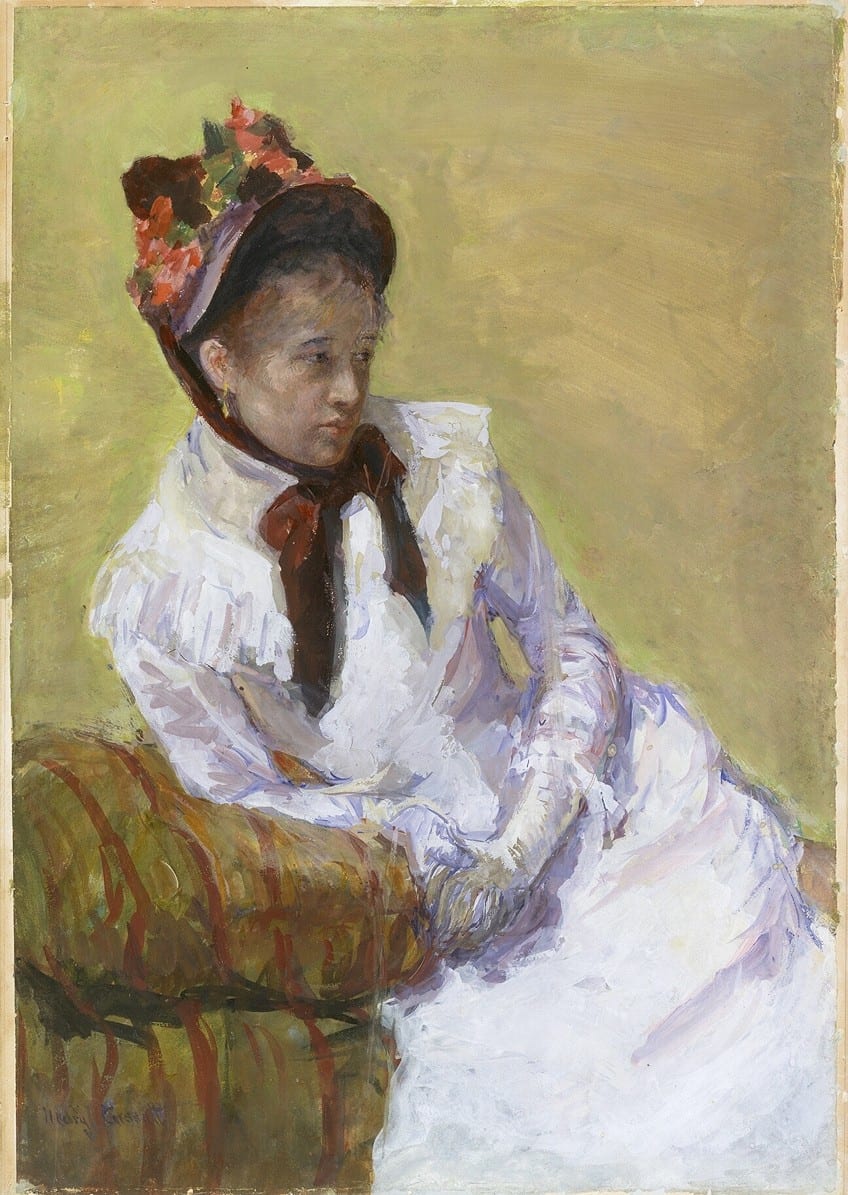
Cassatt met Havemeyer in 1974 when she was an American art student visiting Paris. Cassatt and Havemeyer became great friends over the years. Havenmeyer became a patron of Cassatt’s work and Impressionist art in general. She later donated much of her art collection to The Metropolitan Museum of Art in New York City.
Lydia Reading the Morning Paper (1878 – 1879)
| Artwork Title | Lydia Reading the Morning Paper |
| Date | 1878 – 1879 |
| Medium | Oil on canvas |
| Size (cm) | 98.42 x 78.74 |
| Collection | Joslyn Art Museum, Nebraska, United States |
In this painting, Cassatt used her sister, Lydia, as a model. Lydia was one of Cassatt’s favorite people to paint and the sisters shared a close bond. In full Impressionist style, Lydia is painted in bright pastel colors and loose, dynamic brushstrokes. Lydia is posed in a seated position in an armchair and is painted in an asymmetrical composition, sitting diagonally across the canvas.
The work is a depiction of a modern woman, reading a newspaper.
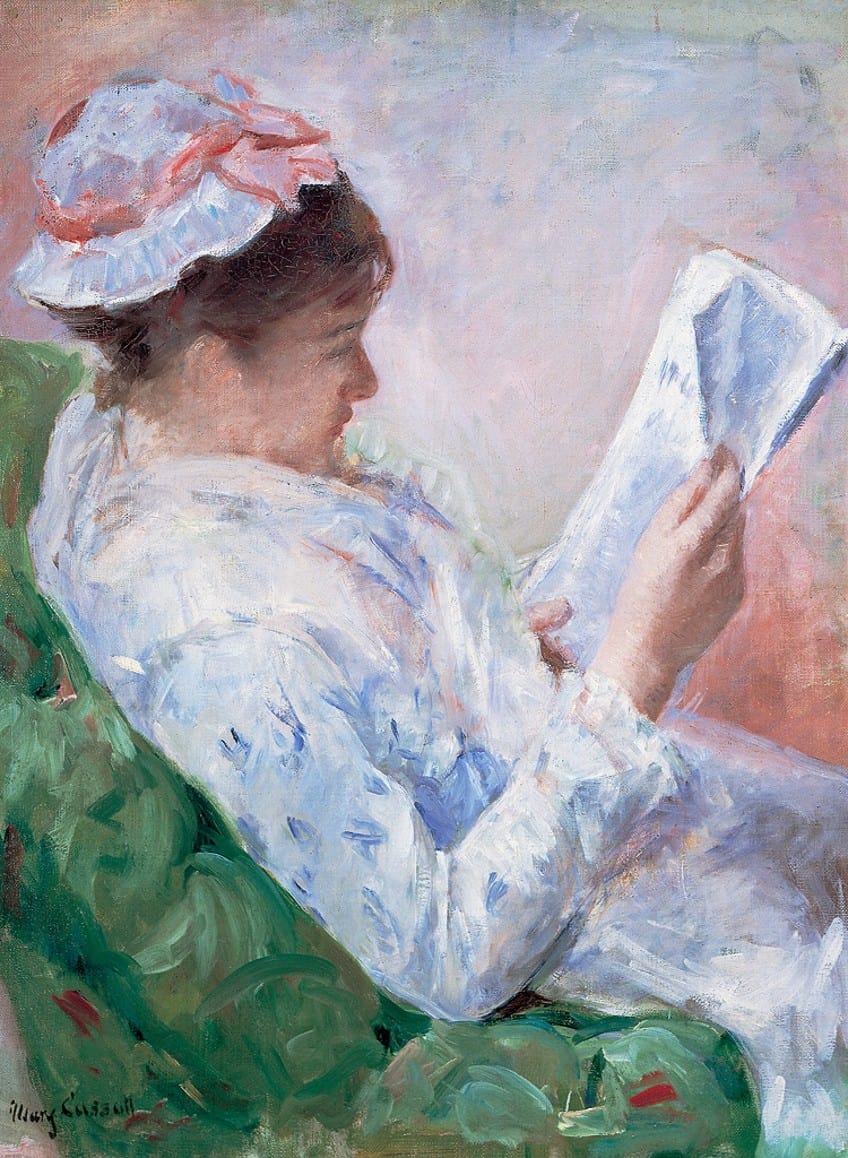
Using a newspaper as opposed to a romantic novel, Cassatt is asserting the importance not only of women’s education and ability to read, but she is also stressing their intellectual capacity to be concerned with current events. In the late 19th century, awareness of current events in society, such as discussions about women’s rights to vote, would be published in newspapers, amongst other places.
A Woman and a Girl Driving (1881)
| Artwork Title | A Woman and a Girl Driving |
| Date | 1881 |
| Medium | Oil on canvas |
| Size (cm) | 130.5 x 89.6 |
| Collection | The Philadelphia Museum of Art, Philadelphia, United States |
In this early painting, we already see Cassatt’s depiction of the modern woman. The painting features two female figures sitting in a carriage. One of the women is Cassatt’s sister, Lydia, and the other is the young niece of Edgar Degas. The painting has a strange vantage point and features blurred details. This, paired with the modern subject matter, made Cassatt’s work unique, especially when compared to her American contemporaries.
Cassatt felt more at home in France and spent most of her life living and working in Paris.
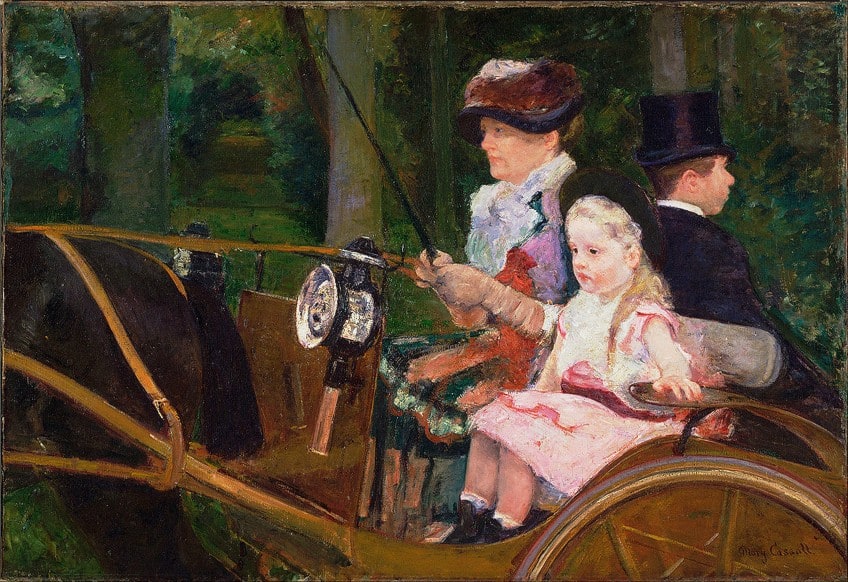
The setting of this painting is the Bois de Boulogne, which was a popular social setting at the time. The painting shows the older woman holding the reins to the horse, highlighting the adult-child relationship where the child is learning from the older woman. Depicting women in any kind of physical activity, no matter how respectable, was very unusual at the time, making this painting quite modern indeed.
Portrait of Alexander J. Cassatt and His Son, Robert Kelso Cassatt (1884)
| Artwork Title | Portrait of Alexander J. Cassatt and His Son, Robert Kelso Cassatt |
| Date | 1884 |
| Medium | Oil on canvas |
| Size (cm) | 100.3 x 81.3 |
| Collection | The Philadelphia Museum of Art, Philadelphia, United States |
This work was painted in December of 1884 when Mary Cassatt’s brother, Alexander Cassatt, and his son Robert Kelso Cassatt, decided to visit their family in Paris for a month. The portrait of Alexander and his son is painted with a keen observation, showing the family resemblance between the older and younger man.
Similarities can be seen through the redness in their cheeks, the focus in their eyes, and their dark clothing.
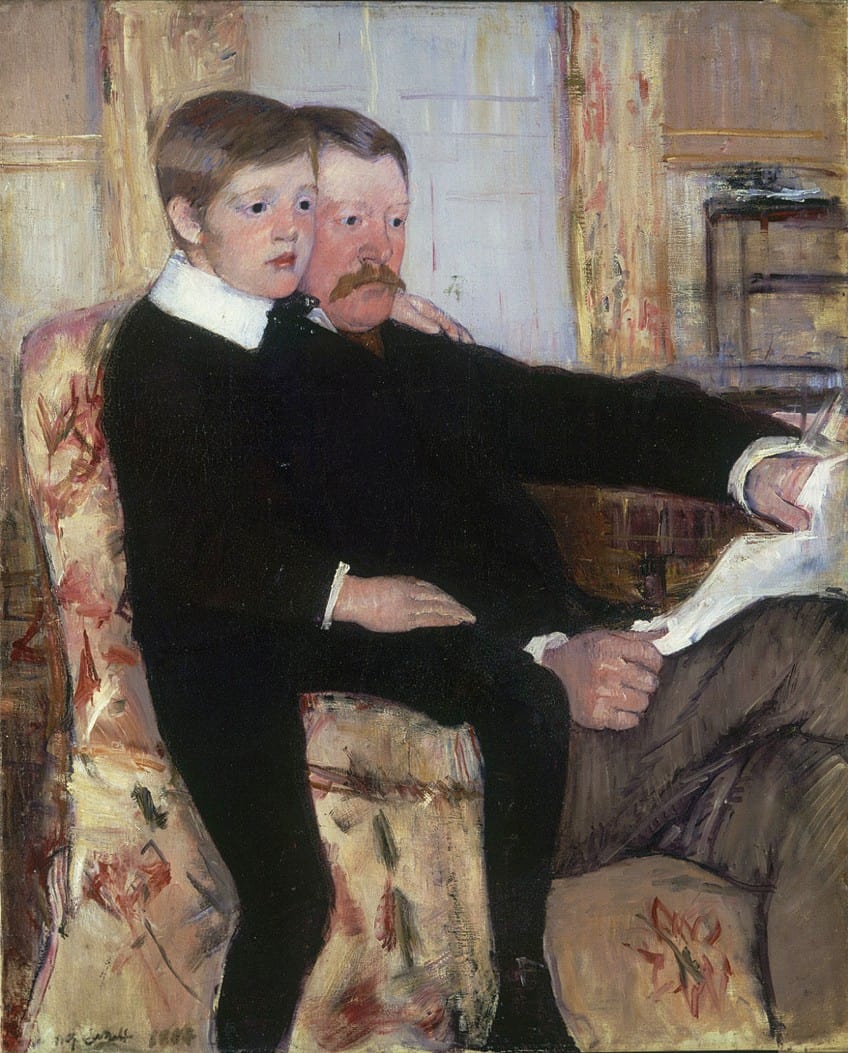
The bond between Alexander and his son is captured in what seems to be an intimate and private moment of embrace. Alexander Cassatt was a very successful and famous businessman, and it was unusual for prominent men to be portrayed in such moments of affection, which was normally reserved for the depictions of women in paintings. Instead of focusing on his status and fame, Cassatt chose to portray the softer father persona of her brother.
Mother’s Kiss (1890 – 1891)
| Artwork Title | Mother’s Kiss |
| Date | 1890 – 1891 |
| Medium | Drypoint and aquatint on paper |
| Size (cm) | 34.9 x 22.8 |
| Collection | National Museum of Women in the Arts, Washington D.C., United States |
This important work is one of Mary Cassatt’s prints. Cassatt was an incredibly skilled and daring printmaker. Mother’s Kiss (1890 – 1891) is part of a series of 10 works exhibited in the Galarie Durand-Ruel in 1891 in Paris. Among these 10 works is also Cassatt’s famous print, The Bath (1891) The prints show how greatly Cassatt was inspired by the Japanese prints that were exhibited in 1890 at the Ecole des Beaux-Arts in Paris.
Following the simplicity of design found in Japanese art, the prints show a restraint in line and color. The work, however, stays true to Cassatt’s earlier work as a golden thread of keen observation of mother and child relationships can be seen in this work.
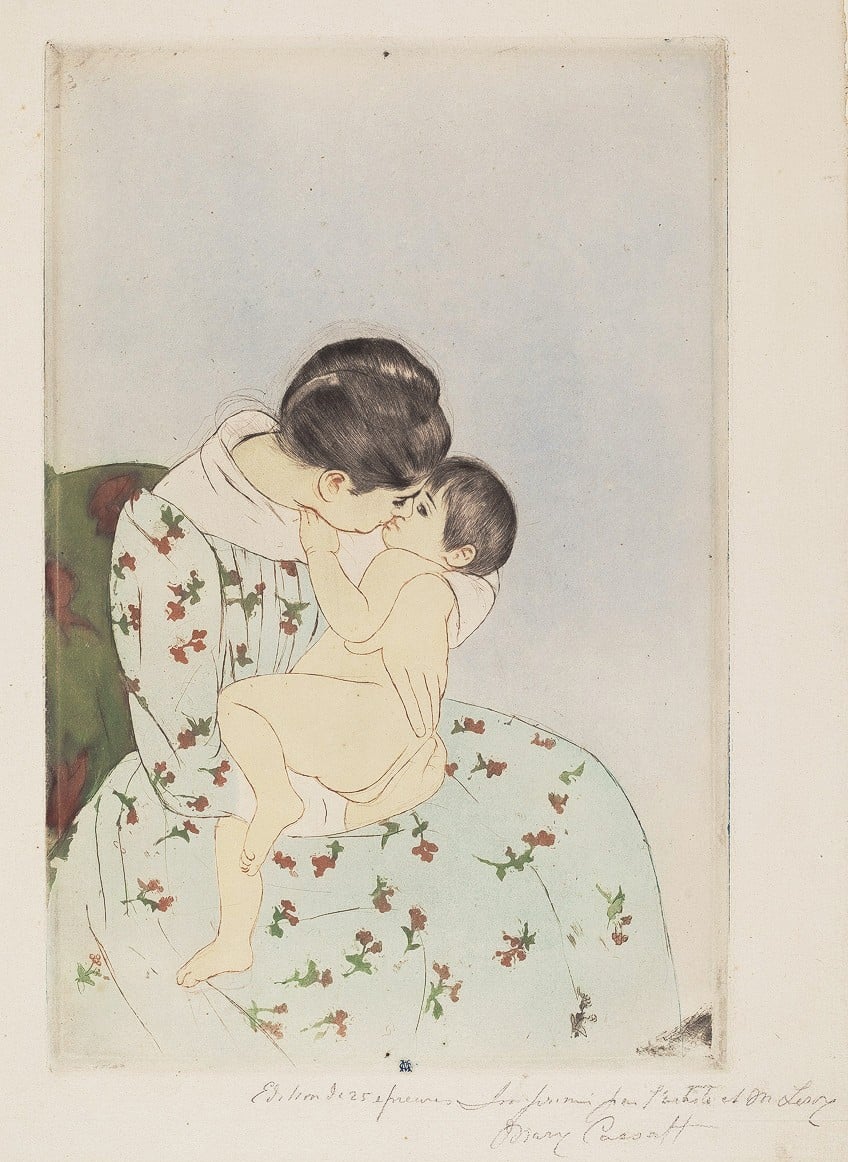
The mother and child figures appear almost flat in their simplicity and in these works, Cassatt completely abandoned the traditional Western tradition of shading and using tones to create the perception of depth. Cassatt’s mother and child appear neither Asian nor European, making it easier to focus purely on the intimate relationship between the two, regardless of the cultural setting.
Woman with a Sunflower (1905)
| Artwork Title | Woman with a Sunflower |
| Date | c. 1905 |
| Medium | Oil on canvas |
| Size (cm) | 92.1 x 73.7 |
| Collection | The National Gallery of Art, Washington D.C., United States |
This late work of Cassatt is a child and mother painting, one of many that the artist created over her career. Cassatt’s first child and mother painting was created in the 1880s and by the 1890s it has become her specialized subject. Mary Cassatt’s paintings were created from real-life settings and she needed to develop quick observation skills to capture the fleeting moments between mother and child, especially considering the active nature of children. In this work, Cassatt keenly observes a moment between mother and child in a complex arrangement of a room with two mirrors.
Whilst many male artists in the past created compositions of women and mirrors, Cassatt’s work is unique as the mirror is not used as an object of vanity, but rather as an object that reflects the loving relationship between the mother and child.
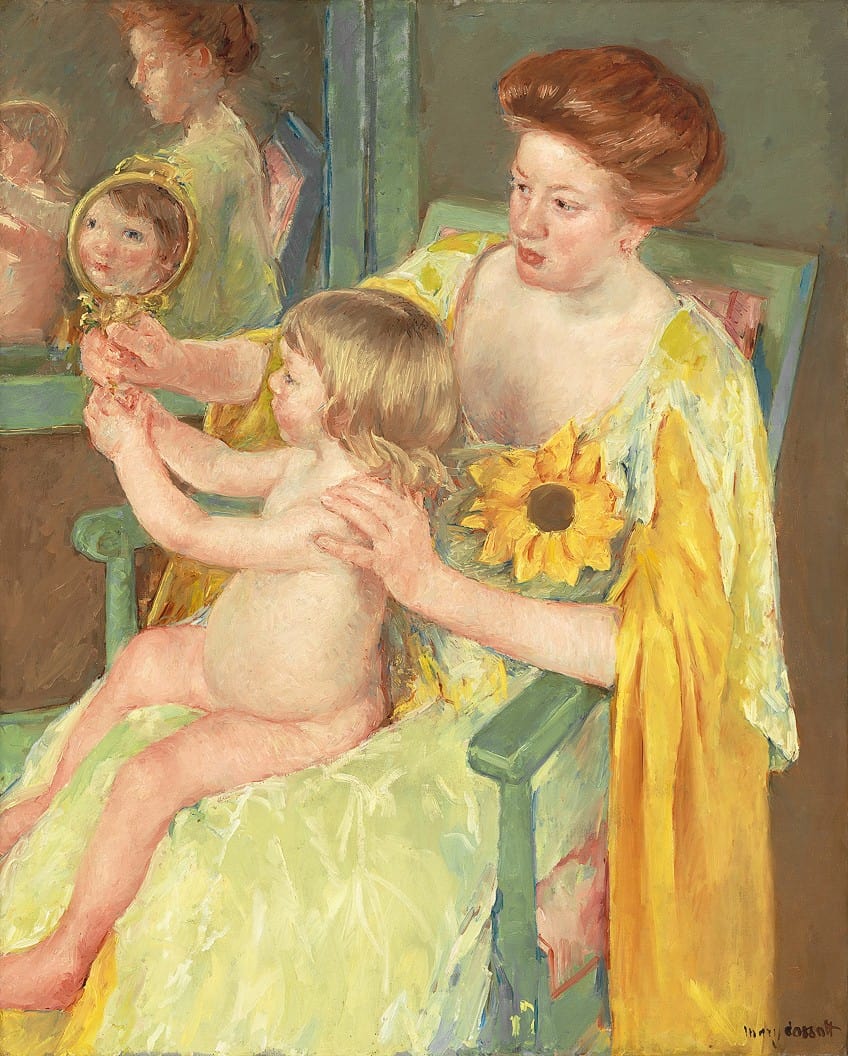
Reading Recommendations
Mary Cassatt’s vibrant and observant works come alive in the beautifully illustrated books recommended below. These books are, however, not only picture page-through books but offer valuable insight into Cassatt’s work through informed text. We recommend that you start with these as you explore the incredible works of this important artist in more depth.
Mary Cassatt: Paintings and Prints (1980) by Frank Getlein
Published while Cassatt was still alive, this book is a must-have for your collection. Written by the notable art critic and historian, Frank Getlein, the book offers an intimate view into 72 innovative and important works of Cassatt. Getlein gives background into these works, explaining their significance in context with details of Cassatt’s lived experience as a 19th century female artist.
- The first time that so many of Cassatt's paintings and prints are available
- Includes some prints rarely seen by American audiences
- A close view of 72 of Cassatt's important works of art
Mary Cassatt: Modern Woman (1998) by Judith Barter
This book is published alongside a retrospective exhibition of Mary Cassatt’s work at the Art Institute of Chicago in 1998. The book discusses in depth the life of Mary Cassatt, her contribution as a female Impressionist, and her influence on the American art world. The publication includes the reproduction of an impressive amount of Cassatt’s work, along with reproductions of other artists that influenced her life and work.
- A close look at the life of artist Mary Cassatt
- Published alongside a retrospective of Cassatt's work in Chicago
- Includes a selection of essays on Cassatt's distinct artistic style
Meet Mary Cassatt (2022) by Read With You Centre for Excellence in STEAM Education
This book is an excellent choice for introducing young readers to the art of Mary Cassatt. Beautifully illustrated and easily written, the publication offers an engaging introduction to her work, placing it in context with the times. Each page of the book is colorful, offering a variety of interesting facts and creative questions to help readers develop the skills to understand and analyze art from a young age.
- Ideal for young readers being introduced to the art world
- Clear and easy for children to understand and follow
- Colorful pages with interesting facts about Cassatt
Mary Cassatt was through and through a modern woman. Refusing marriage, she decided to dedicate her life to her art and her own personal development. Apart from the undeniable beauty of her works, her paintings and prints of the everyday woman challenged and subverted the perception and portrayal of women at the time. Her modern subject matter, keen eye, experimental nature, and honed skills makes Mary Cassatt one of the most important female figures in art history.
Take a look at our Mary Cassatt paintings webstory here!
Frequently Asked Questions
Did Mary Cassatt Ever Marry and Have Children?
Throughout her life, Mary Cassatt strived for independence. This was not an easy task, as female painters were rare and often paid much less than their male counterparts. Cassatt luckily came from a wealthy family and while they didn’t always support her artistic endeavors, she would not go hungry. This made it possible for Cassatt to refuse marriage as she believed it would negatively affect her career. Being an artist did not match the expectations of being a wife at the time. Cassatt also never had any children.
Did Mary Cassatt and Edgar Degas Have a Romantic Relationship?
Cassatt and Degas were friends for decades. Both admired each other’s work and enjoyed each other’s company. Degas respected Cassatt and valued her opinions. Cassatt, at some point, did develop feelings for Degas, but decided not to pursue a romantic relationship as she found his nature to be too feeble.
Liam Davis is an experienced art historian with demonstrated experience in the industry. After graduating from the Academy of Art History with a bachelor’s degree, Liam worked for many years as a copywriter for various art magazines and online art galleries. He also worked as an art curator for an art gallery in Illinois before working now as editor-in-chief for artfilemagazine.com. Liam’s passion is, aside from sculptures from the Roman and Greek periods, cave paintings, and neolithic art.
Learn more about Liam Davis and about us.
Cite this Article
Liam, Davis, “Mary Cassatt – A Pioneer of the Impressionism Movement.” artfilemagazine – Your Online Art Source. June 19, 2023. URL: https://artfilemagazine.com/mary-cassatt/
Davis, L. (2023, 19 June). Mary Cassatt – A Pioneer of the Impressionism Movement. artfilemagazine – Your Online Art Source. https://artfilemagazine.com/mary-cassatt/
Davis, Liam. “Mary Cassatt – A Pioneer of the Impressionism Movement.” artfilemagazine – Your Online Art Source, June 19, 2023. https://artfilemagazine.com/mary-cassatt/.


